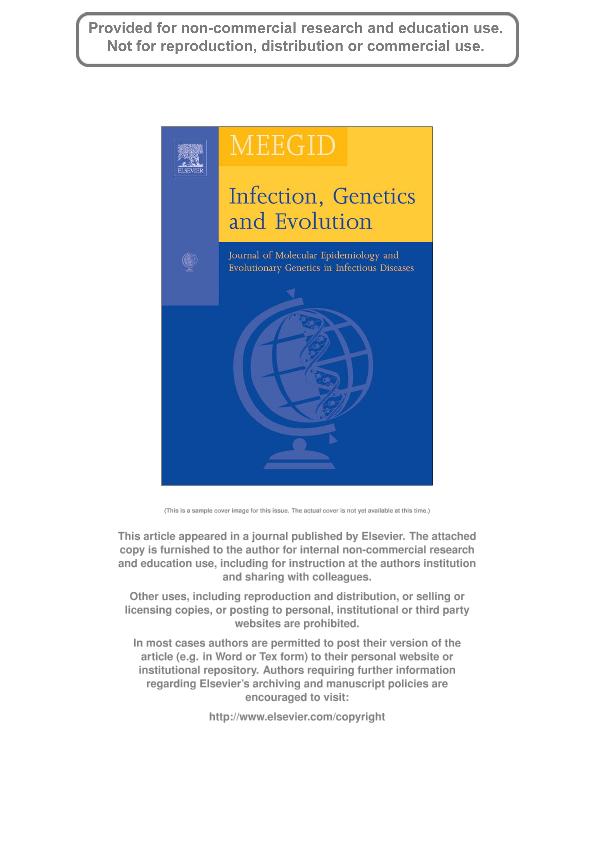Mostrar el registro sencillo del ítem
dc.contributor.author
Schnittger, Leonhard

dc.contributor.author
Rodriguez, Anabel Elisa

dc.contributor.author
Jacobsen, Monica Ofelia

dc.contributor.author
Morrison, David A.
dc.date.available
2023-04-21T12:19:31Z
dc.date.issued
2012-03
dc.identifier.citation
Schnittger, Leonhard; Rodriguez, Anabel Elisa; Jacobsen, Monica Ofelia; Morrison, David A.; Babesia: a world emerging; Elsevier Science; Infection, Genetics and Evolution; 12; 8; 3-2012; 1788-1809
dc.identifier.issn
1567-1348
dc.identifier.uri
http://hdl.handle.net/11336/194855
dc.description.abstract
Babesia are tick-transmitted hemoprotozooans that infect mammals and birds, and which are acknowledged for their major impact on farm and pet animal health and associated economic costs worldwide. Additionally, Babesia infections of wildlife can be fatal if associated with stressful management practices; and human babesiosis, also transmitted by blood transfusion, is an increasing public-health concern. Due to the huge diversity of species reported to serve as Babesia hosts, all vertebrates might be potential carriers, as long as they are adequate hosts for Babesia-vector ticks. We here provide a comprehensive overview of the most relevant Babesia species, and a discussion of the classical taxonomic criteria. Babesia, Cytauxzoon and Theileria parasites are closely related and collectively referred to as piroplasmids. A possible scenario for the history of piroplasmids is presented in the context of recent findings, and its implications for future research avenues are outlined. Phylogenetic trees of all available 18S rRNA and hsp70 genes were generated, based on which we present a thoroughly revised molecular classification, comprising five monophyletic Babesia lineages, one Cytauxzoon clade, and one Theileria clade. Updated 18S rRNA and beta-tubulin gene trees of the B. microti isolates agree with those previously reported. To reconcile estimates of the origin of piroplasmids and ticks (∼300. Ma, respectively), and mammalian radiation (60. Ma), we hypothesize that the dixenous piroplasmid life cycle evolved with the origin of ticks. Thus, the observed time gap between tick origin and mammalian radiation indicates the existence of hitherto unknown piroplasmid lineages and/or species in extant vertebrate taxa, including reptiles and possibly amphibians. The development and current status of the molecular taxonomy of Babesia, with emphasis on human-infecting species, is discussed. Finally, recent results from population genetic studies of Babesia parasites, and their implications for the development of pathogenicity, drug resistance and vaccines, are summarized.
dc.format
application/pdf
dc.language.iso
eng
dc.publisher
Elsevier Science

dc.rights
info:eu-repo/semantics/openAccess
dc.rights.uri
https://creativecommons.org/licenses/by-nc-sa/2.5/ar/
dc.subject
BABESIA
dc.subject
EVOLUTION
dc.subject
MOLECULAR PHYLOGENY
dc.subject
MOLECULAR TAXONOMY
dc.subject
POPULATION GENETICS
dc.subject
THEILERIA
dc.subject.classification
Conservación de la Biodiversidad

dc.subject.classification
Ciencias Biológicas

dc.subject.classification
CIENCIAS NATURALES Y EXACTAS

dc.title
Babesia: a world emerging
dc.type
info:eu-repo/semantics/article
dc.type
info:ar-repo/semantics/artículo
dc.type
info:eu-repo/semantics/publishedVersion
dc.date.updated
2023-04-20T12:31:22Z
dc.journal.volume
12
dc.journal.number
8
dc.journal.pagination
1788-1809
dc.journal.pais
Países Bajos

dc.journal.ciudad
Amsterdam
dc.description.fil
Fil: Schnittger, Leonhard. Consejo Nacional de Investigaciones Científicas y Técnicas; Argentina. Instituto Nacional de Tecnología Agropecuaria. Centro de Investigación en Ciencias Veterinarias y Agronómicas. Instituto de Patobiología; Argentina
dc.description.fil
Fil: Rodriguez, Anabel Elisa. Consejo Nacional de Investigaciones Científicas y Técnicas; Argentina. Instituto Nacional de Tecnología Agropecuaria. Centro de Investigación en Ciencias Veterinarias y Agronómicas. Instituto de Patobiología; Argentina
dc.description.fil
Fil: Jacobsen, Monica Ofelia. Instituto Nacional de Tecnología Agropecuaria. Centro de Investigación en Ciencias Veterinarias y Agronómicas. Instituto de Patobiología; Argentina. Consejo Nacional de Investigaciones Científicas y Técnicas; Argentina
dc.description.fil
Fil: Morrison, David A.. Swedish University of Agricultural Sciences; Suecia
dc.journal.title
Infection, Genetics and Evolution

dc.relation.alternativeid
info:eu-repo/semantics/altIdentifier/doi/http://dx.doi.org/10.1016/j.meegid.2012.07.004
Archivos asociados
